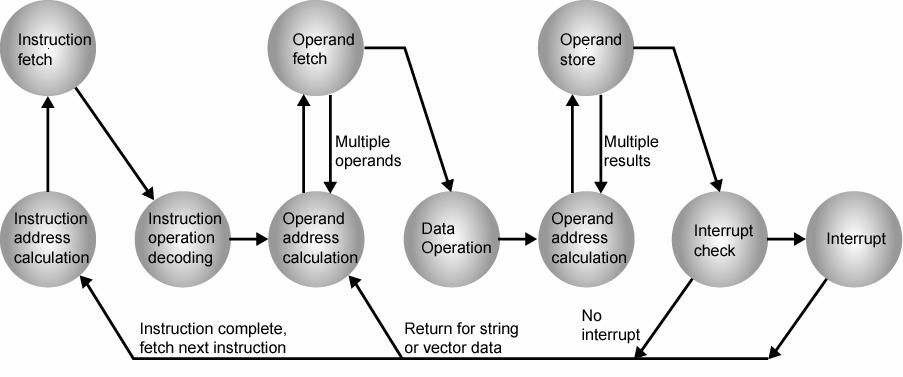| << Chapter < Page | Chapter >> Page > |
To accommodate interrupts, an interrupt cycle is added to the instruction cycle, as shown in Figure 7. In the interrupt cycle, the processor checks to see if any interrupts have occurred, indicated by the presence of an interrupt signal. If no interrupts arc pending, the processor proceeds to the fetch cycle and fetches the next instruction of the current program. If an interrupt is pending, the processor does the following:

Figure 7: Instruction Cycle with Interrupts.
The processor now proceeds to the fetch cycle and fetches the first instruction in the interrupt handler program, which will service the interrupt. The interrupt handler program is generally part of the operating system. Typically, this program determines the nature of the interrupt and performs whatever actions are needed. In the example we have been using, the handler determines which I/O module generated the interrupt, and may branch to a program that will write more data out to that I/O module. When the interrupt handler routine is completed, the processor can resume execution of the user program at the point of interruption. Figure 8 shows a revised instruction cycle state diagram that includes interrupt cycle processing.

Figure 8: Instruction cycle state diagram with interrupt
In some cases, multiple interrupts can occur. For example, a program may be receiving data from a communications line and printing results. The printer will generate an interrupt every lime that it completes a print operation. The communication line controller will generate an interrupt every time a unit of data arrives. I he unit could either be a single character or a block, depending on the nature of the communications discipline. In any case, it is possible for a communications interrupt to occur while a printer interrupt is being processed. Two approaches can be taken to dealing with multiple interrupts:
The first is to disable interrupts while an interrupt is being processed. A disabled interrupt simply means that the processor can and will ignore that interrupt request signal. If an interrupt occurs during this time, it generally remains pending and will be cheeked by the processor after the processor has enabled interrupts. Thus, when a user program is executing and an interrupt occurs, interrupts are disabled immediately. After the interrupt handler routine completes, interrupts are enabled before resuming the user program, and the processor checks to see if additional interrupts have occurred. This approach is nice and simple, as interrupts are handled in strict sequential order (Figure 2.10).

Notification Switch
Would you like to follow the 'Computer architecture' conversation and receive update notifications?